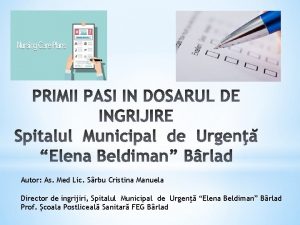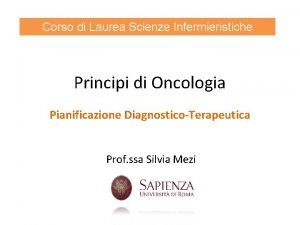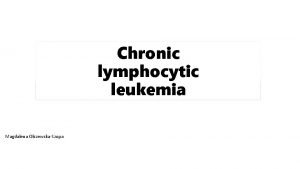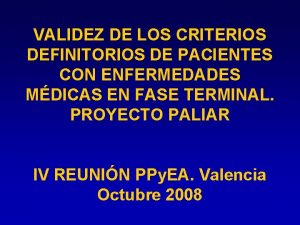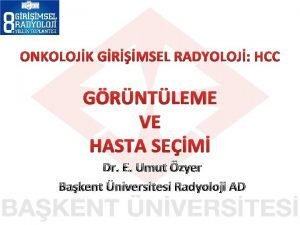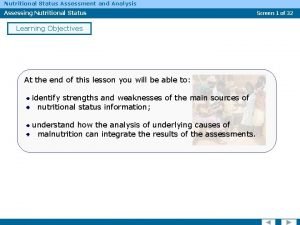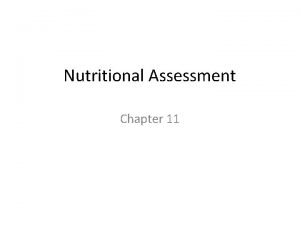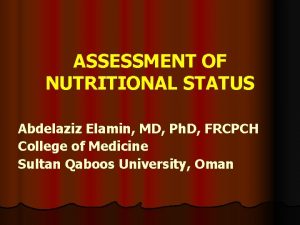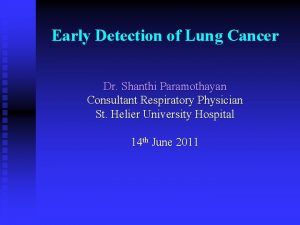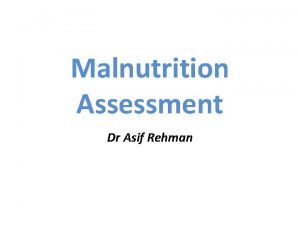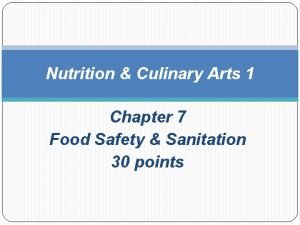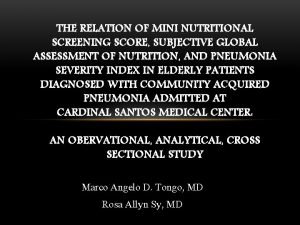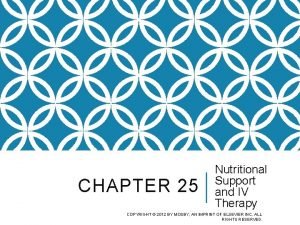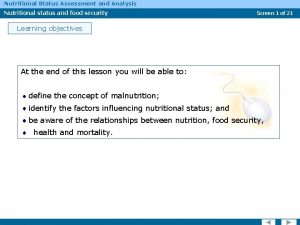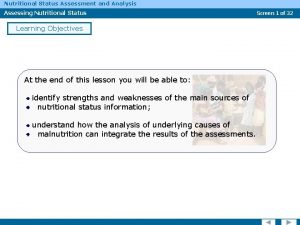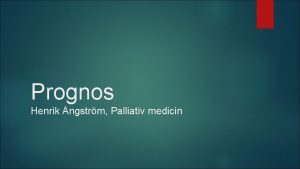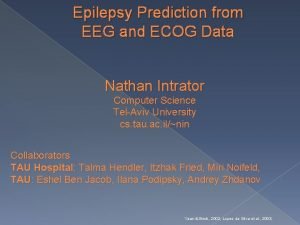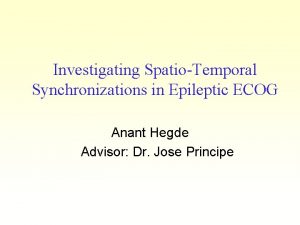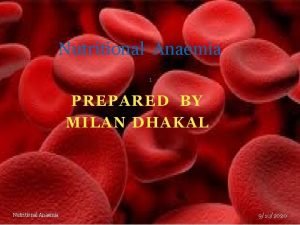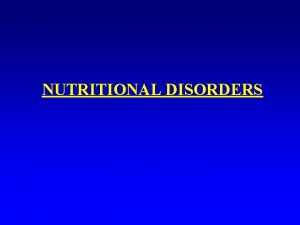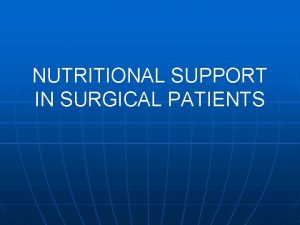NUTRITIONAL STATUS IS SUPERIOR TO THE ECOG PERFORMANCE















- Slides: 15

NUTRITIONAL STATUS IS SUPERIOR TO THE ECOG PERFORMANCE STATUS IN PREDICTING THE DOSE-INTENSITY OF THE GEMOX CHEMOTHERAPY REGIMEN IN PATIENTS WITH ADVANCED CANCER GABRIELLE SHERER ONCOLOGY JENNIFER MAHNKE MS RD CSO LD

CITATION Cessot A, Coriat R, Mir O, et al. Nutritional status is superior to the ECOG performance status in predicting the doseintensity of the GEMOX chemotherapy regimen in patients with advanced cancer. Nutr and Cancer. 2013; 65(8): 1254 -1257. doi: 10. 1080/01635581. 2013. 830315

BACKGROUND Increasing number of cancer pts are elderly w/ comorbidities and/or advanced condition Altered PS “unfit” for clinical trials Inadequate evidence to determine treatment of fragile and/or malnourished pts Feasibility of chemo based on: § PS § Chemo exposition markers (liver/renal conditions) § Bone marrow reserve estimations Malnourishment in 40 -80% of ca pts – correlation btw nutrition status and chemo tolerance

EASTERN COOPERATIVE ONCOLOGY GROUP (ECOG) PERFORMANCE STATUS (PS) Grad e ECOG 0 Fully active, able to carry on all pre-disease performance without restriction 1 Restricted in physically strenuous activity but ambulatory and able to carry out work of a light or sedentary nature, e. g. , light house work, office work 2 Ambulatory and capable of all selfcare but unable to carry out any work activities. Up and about more than 50% of waking hours 3 Capable of only limited selfcare, confined to bed or chair more than 50% of waking hours 4 Completely disabled. Cannot carry on any selfcare. Totally confined to bed or chair 5 Dead

GEMOX Gemcitabine - pyrimidine antimetabolite (inhibits DNA production) Oxaliplatin - alkylating agent (damages DNA) Moderately Toxic

OBJECTIVE Does nutritional status identify patients who are at risk of failure to complete the planned chemotherapy schedule among those receiving GEMOX?

DESIGN, PARTICIPANTS & SETTING Retrospective cohort study Cochin Teaching Hospital Nov 2006 -Oct 2010 165 unselected, consecutive ca pts treated w/ GEMOX- no exclusion

METHODS Baseline parameters: § Age § Gender § Ht § Primary tumor § ECOG PS § Usual wt § Baseline wt § Alb § CRP § Lymph count § Hemoglobin Scheduled Dose Intensity § Gemcitabine 500 mg/m 2/wk § Oxaliplatin 42. 5 mg/m 2/wk

OUTCOME MEASURES Relative Dose Intensity (RDI) observed dose intensity / scheduled dose intensity Discontinuance of chemotherapy: § Receiving less than 2 cycles of GMOX Malnutrition: § BMI under 18. 5 kg/m 2 § Premorbid wt loss over 10% § Albuminemia under 35 g/L

STATISTICAL ANALYSIS Student’s test § Compare means btw groups (A: pts receiving 2 cycles or less. B: pts receiving more than 2 cycles) Kruskal-Wallis test § Compare BMI in PS 0 -1 and 2 -3 pts Chi 2 test § PS scores btw group A and B Pearson’s correlation test § Correlation btw RDI and baseline parameters

RESULTS Median age: 61 yr ECOG PS 0 -1: 71% of pts Malnutrition: 48% of pts § 48% in PS 0 -1 § 61% in PS 2 -3 RDI of GEMOX- significant, neg. correlation with Loss of baseline wt Mean PS higher in group A

CONCLUSIONS Malnutrition is independent of PS Malnutrition is associated with early treatment discontinuance and lower RDI PS did not correlate with RDI, but did correlate with early treatment discontinuance

CLINICAL IMPLICATIONS Nutrition status should be added to PS as a determinant of chemotherapy feasibility, however should not replace it.

NONPROFESSIONAL REFERENCES http: //www. ecog. org/general/perf_stat. html http: //www. uptodate. com/contents/search

 Status de performanta ecog
Status de performanta ecog Scala ecog
Scala ecog Ecog
Ecog Scala ecog
Scala ecog Ecog
Ecog Criterios nho
Criterios nho Meld skoru
Meld skoru Nutritional status assessment
Nutritional status assessment Define optimal nutritional status
Define optimal nutritional status Nutritional assessment abcd
Nutritional assessment abcd Performance status
Performance status Dr shanthi paramothayan
Dr shanthi paramothayan Abcd of nutritional assessment
Abcd of nutritional assessment Culinary nutritional arts
Culinary nutritional arts Subjective global assessment scoring sheet
Subjective global assessment scoring sheet Chapter 28 nutritional support and iv therapy
Chapter 28 nutritional support and iv therapy
